Leadership Report: Planning, Decision Making, and Motivation
VerifiedAdded on 2021/09/30
|13
|2708
|96
Report
AI Summary
This report provides a detailed exploration of planning, decision-making, and motivation within a leadership context. It begins by defining different types of plans (strategic, tactical, operational) and the decision-making process, including identifying problems, generating solutions, and evaluating alternatives. The report also examines formal planning steps, such as situational analysis and goal setting, while also covering cognitive biases that can impact decision-making. Furthermore, it delves into various motivation theories, including Maslow's Hierarchy of Needs, Alderfer's ERG theory, and Herzberg's Two-Factor Theory, as well as process perspectives like Expectancy and Equity theories. The report further analyzes reinforcement perspectives, financial and non-financial motivation strategies. Finally, it discusses organizational design elements such as job specialization and different types of departmentalization (functional, product, customer, geographic, and matrix).
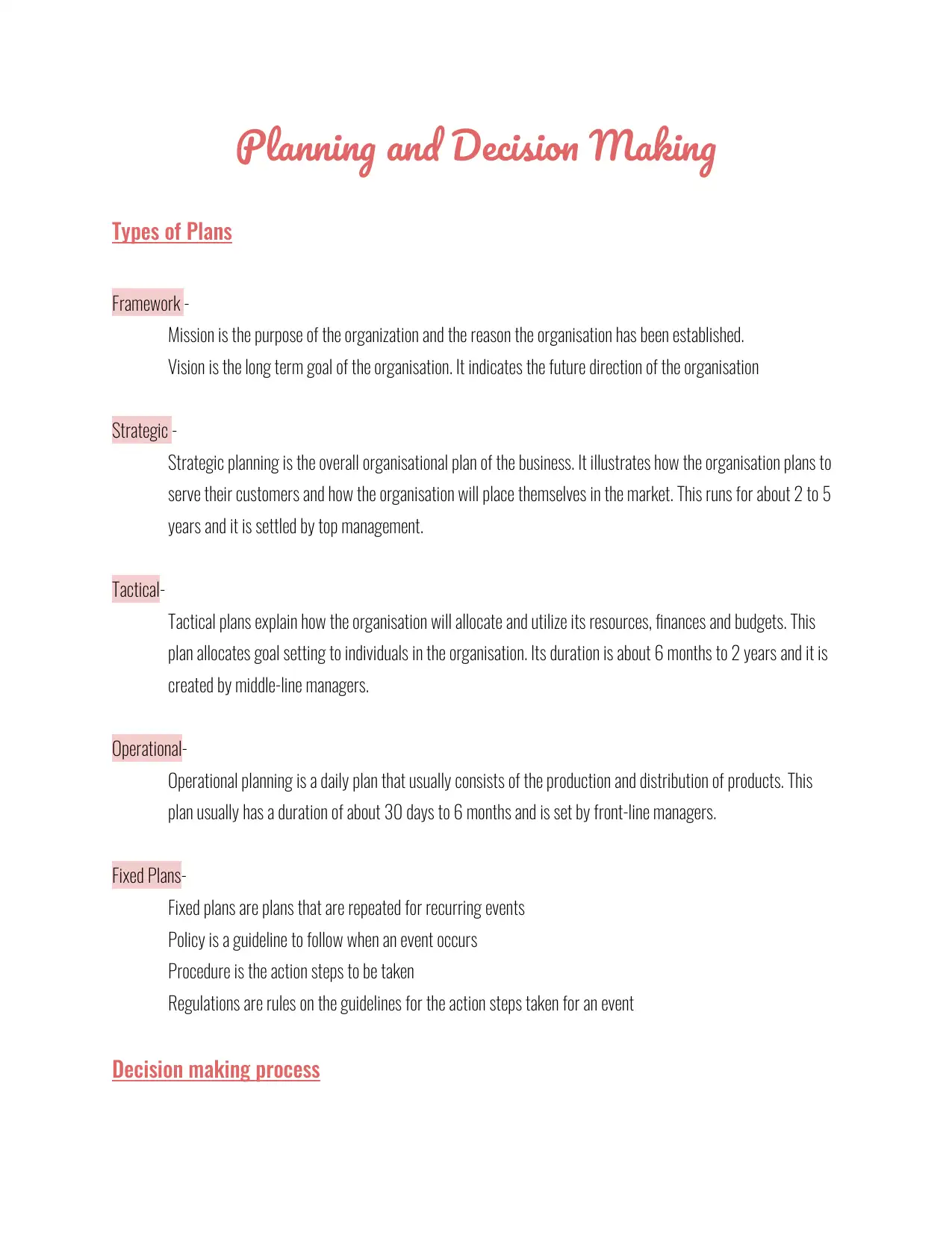
Planning and Decision Making
Types of Plans
Framework -
Mission is the purpose of the organization and the reason the organisation has been established.
Vision is the long term goal of the organisation. It indicates the future direction of the organisation
Strategic -
Strategic planning is the overall organisational plan of the business. It illustrates how the organisation plans to
serve their customers and how the organisation will place themselves in the market. This runs for about 2 to 5
years and it is settled by top management.
Tactical-
Tactical plans explain how the organisation will allocate and utilize its resources, finances and budgets. This
plan allocates goal setting to individuals in the organisation. Its duration is about 6 months to 2 years and it is
created by middle-line managers.
Operational-
Operational planning is a daily plan that usually consists of the production and distribution of products. This
plan usually has a duration of about 30 days to 6 months and is set by front-line managers.
Fixed Plans-
Fixed plans are plans that are repeated for recurring events
Policy is a guideline to follow when an event occurs
Procedure is the action steps to be taken
Regulations are rules on the guidelines for the action steps taken for an event
Decision making process
Types of Plans
Framework -
Mission is the purpose of the organization and the reason the organisation has been established.
Vision is the long term goal of the organisation. It indicates the future direction of the organisation
Strategic -
Strategic planning is the overall organisational plan of the business. It illustrates how the organisation plans to
serve their customers and how the organisation will place themselves in the market. This runs for about 2 to 5
years and it is settled by top management.
Tactical-
Tactical plans explain how the organisation will allocate and utilize its resources, finances and budgets. This
plan allocates goal setting to individuals in the organisation. Its duration is about 6 months to 2 years and it is
created by middle-line managers.
Operational-
Operational planning is a daily plan that usually consists of the production and distribution of products. This
plan usually has a duration of about 30 days to 6 months and is set by front-line managers.
Fixed Plans-
Fixed plans are plans that are repeated for recurring events
Policy is a guideline to follow when an event occurs
Procedure is the action steps to be taken
Regulations are rules on the guidelines for the action steps taken for an event
Decision making process
Paraphrase This Document
Need a fresh take? Get an instant paraphrase of this document with our AI Paraphraser
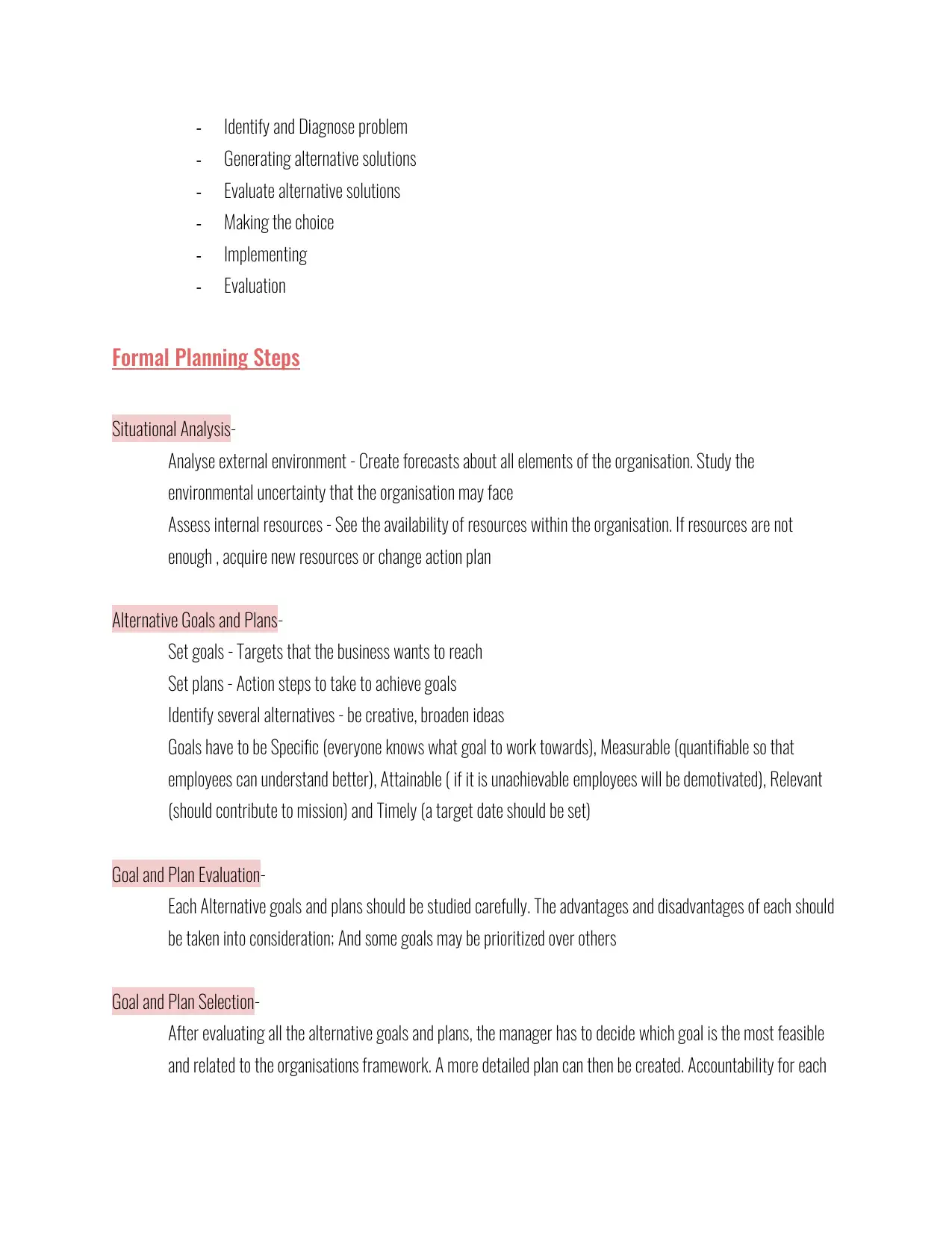
- Identify and Diagnose problem
- Generating alternative solutions
- Evaluate alternative solutions
- Making the choice
- Implementing
- Evaluation
Formal Planning Steps
Situational Analysis-
Analyse external environment - Create forecasts about all elements of the organisation. Study the
environmental uncertainty that the organisation may face
Assess internal resources - See the availability of resources within the organisation. If resources are not
enough , acquire new resources or change action plan
Alternative Goals and Plans-
Set goals - Targets that the business wants to reach
Set plans - Action steps to take to achieve goals
Identify several alternatives - be creative, broaden ideas
Goals have to be Specific (everyone knows what goal to work towards), Measurable (quantifiable so that
employees can understand better), Attainable ( if it is unachievable employees will be demotivated), Relevant
(should contribute to mission) and Timely (a target date should be set)
Goal and Plan Evaluation-
Each Alternative goals and plans should be studied carefully. The advantages and disadvantages of each should
be taken into consideration; And some goals may be prioritized over others
Goal and Plan Selection-
After evaluating all the alternative goals and plans, the manager has to decide which goal is the most feasible
and related to the organisations framework. A more detailed plan can then be created. Accountability for each
- Generating alternative solutions
- Evaluate alternative solutions
- Making the choice
- Implementing
- Evaluation
Formal Planning Steps
Situational Analysis-
Analyse external environment - Create forecasts about all elements of the organisation. Study the
environmental uncertainty that the organisation may face
Assess internal resources - See the availability of resources within the organisation. If resources are not
enough , acquire new resources or change action plan
Alternative Goals and Plans-
Set goals - Targets that the business wants to reach
Set plans - Action steps to take to achieve goals
Identify several alternatives - be creative, broaden ideas
Goals have to be Specific (everyone knows what goal to work towards), Measurable (quantifiable so that
employees can understand better), Attainable ( if it is unachievable employees will be demotivated), Relevant
(should contribute to mission) and Timely (a target date should be set)
Goal and Plan Evaluation-
Each Alternative goals and plans should be studied carefully. The advantages and disadvantages of each should
be taken into consideration; And some goals may be prioritized over others
Goal and Plan Selection-
After evaluating all the alternative goals and plans, the manager has to decide which goal is the most feasible
and related to the organisations framework. A more detailed plan can then be created. Accountability for each
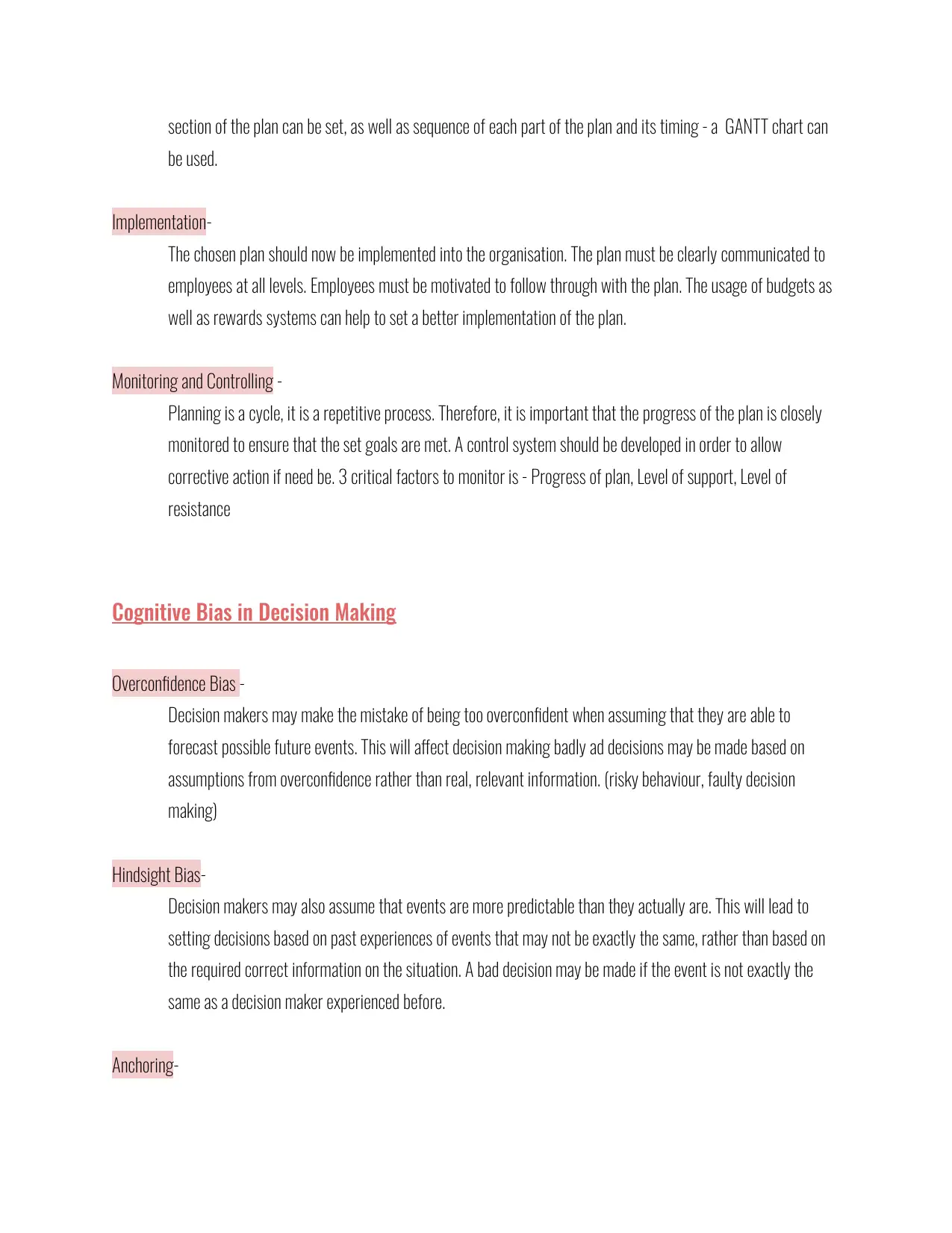
section of the plan can be set, as well as sequence of each part of the plan and its timing - a GANTT chart can
be used.
Implementation-
The chosen plan should now be implemented into the organisation. The plan must be clearly communicated to
employees at all levels. Employees must be motivated to follow through with the plan. The usage of budgets as
well as rewards systems can help to set a better implementation of the plan.
Monitoring and Controlling -
Planning is a cycle, it is a repetitive process. Therefore, it is important that the progress of the plan is closely
monitored to ensure that the set goals are met. A control system should be developed in order to allow
corrective action if need be. 3 critical factors to monitor is - Progress of plan, Level of support, Level of
resistance
Cognitive Bias in Decision Making
Overconfidence Bias -
Decision makers may make the mistake of being too overconfident when assuming that they are able to
forecast possible future events. This will affect decision making badly ad decisions may be made based on
assumptions from overconfidence rather than real, relevant information. (risky behaviour, faulty decision
making)
Hindsight Bias-
Decision makers may also assume that events are more predictable than they actually are. This will lead to
setting decisions based on past experiences of events that may not be exactly the same, rather than based on
the required correct information on the situation. A bad decision may be made if the event is not exactly the
same as a decision maker experienced before.
Anchoring-
be used.
Implementation-
The chosen plan should now be implemented into the organisation. The plan must be clearly communicated to
employees at all levels. Employees must be motivated to follow through with the plan. The usage of budgets as
well as rewards systems can help to set a better implementation of the plan.
Monitoring and Controlling -
Planning is a cycle, it is a repetitive process. Therefore, it is important that the progress of the plan is closely
monitored to ensure that the set goals are met. A control system should be developed in order to allow
corrective action if need be. 3 critical factors to monitor is - Progress of plan, Level of support, Level of
resistance
Cognitive Bias in Decision Making
Overconfidence Bias -
Decision makers may make the mistake of being too overconfident when assuming that they are able to
forecast possible future events. This will affect decision making badly ad decisions may be made based on
assumptions from overconfidence rather than real, relevant information. (risky behaviour, faulty decision
making)
Hindsight Bias-
Decision makers may also assume that events are more predictable than they actually are. This will lead to
setting decisions based on past experiences of events that may not be exactly the same, rather than based on
the required correct information on the situation. A bad decision may be made if the event is not exactly the
same as a decision maker experienced before.
Anchoring-
⊘ This is a preview!⊘
Do you want full access?
Subscribe today to unlock all pages.

Trusted by 1+ million students worldwide

Decision makers often have the tendency to rely too much on one piece of information when making decisions
instead of putting the effort to investigate further to uncover further relevant information. This tendency will
lead to faulty decisions as well as lost opportunities.
Framing Bias-
Another issue that may be faced while decision making is that the way in which a situation is presented can
have a strong influence on the decision that is made. This may lead to bad decision as the way a problem is
framed may be inaccurate.
Escalation of Commitment-
People proceed on a failing course of action because they already invested in it. Managers may fear admitting
that they are wrong or believe they can recover their losses. Or believe they can recover their losses
Groupthink-
Members of a group put pressure on each other to conform and reach consensus, thereby increasing the risk of
flawed decisions. Reduces mental efficiency, reality testing, and moral judgement in making decisions.
Motivation
Content Perspectives
Maslow’s Hierarchy Approach-
instead of putting the effort to investigate further to uncover further relevant information. This tendency will
lead to faulty decisions as well as lost opportunities.
Framing Bias-
Another issue that may be faced while decision making is that the way in which a situation is presented can
have a strong influence on the decision that is made. This may lead to bad decision as the way a problem is
framed may be inaccurate.
Escalation of Commitment-
People proceed on a failing course of action because they already invested in it. Managers may fear admitting
that they are wrong or believe they can recover their losses. Or believe they can recover their losses
Groupthink-
Members of a group put pressure on each other to conform and reach consensus, thereby increasing the risk of
flawed decisions. Reduces mental efficiency, reality testing, and moral judgement in making decisions.
Motivation
Content Perspectives
Maslow’s Hierarchy Approach-
Paraphrase This Document
Need a fresh take? Get an instant paraphrase of this document with our AI Paraphraser
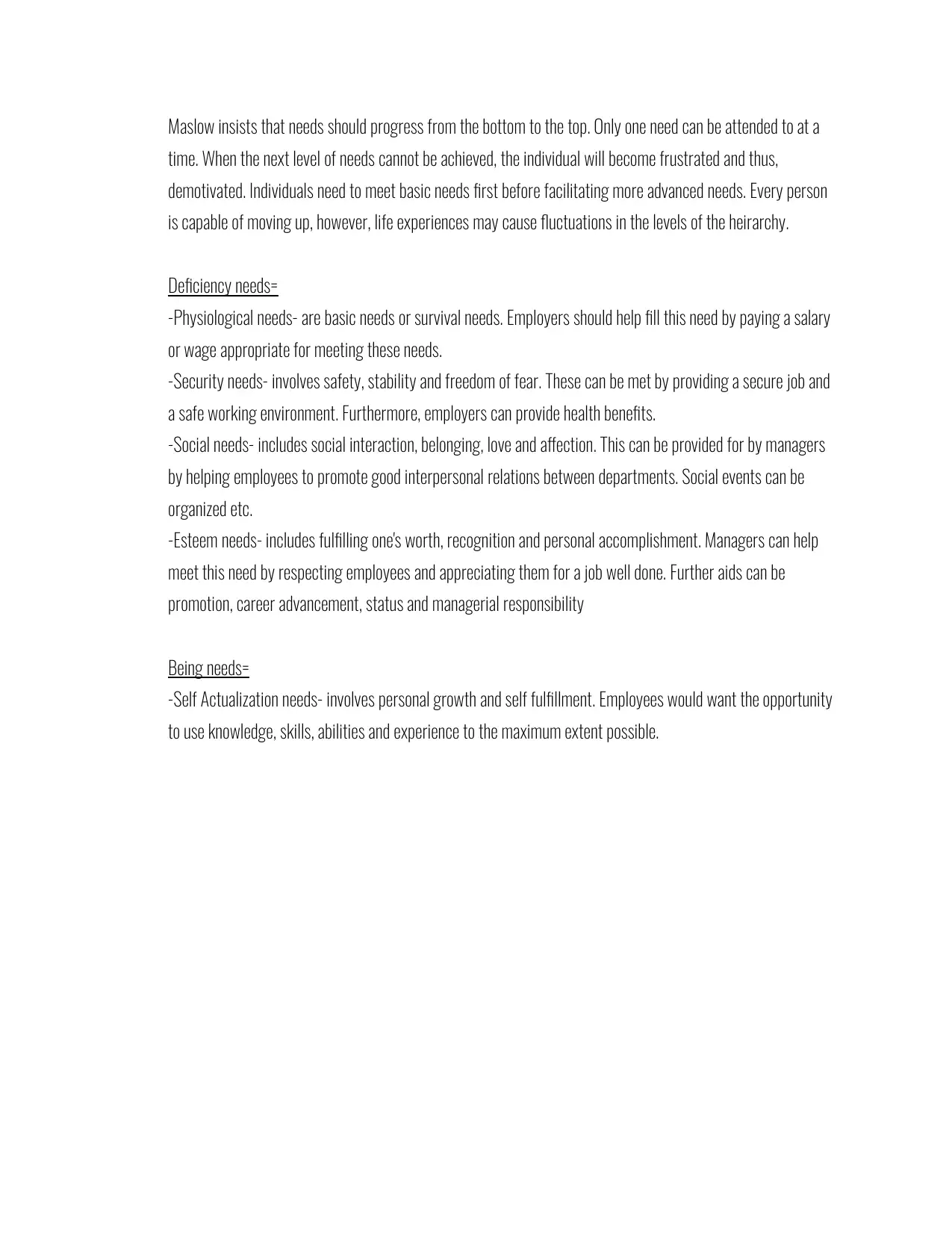
Maslow insists that needs should progress from the bottom to the top. Only one need can be attended to at a
time. When the next level of needs cannot be achieved, the individual will become frustrated and thus,
demotivated. Individuals need to meet basic needs first before facilitating more advanced needs. Every person
is capable of moving up, however, life experiences may cause fluctuations in the levels of the heirarchy.
Deficiency needs=
-Physiological needs- are basic needs or survival needs. Employers should help fill this need by paying a salary
or wage appropriate for meeting these needs.
-Security needs- involves safety, stability and freedom of fear. These can be met by providing a secure job and
a safe working environment. Furthermore, employers can provide health benefits.
-Social needs- includes social interaction, belonging, love and affection. This can be provided for by managers
by helping employees to promote good interpersonal relations between departments. Social events can be
organized etc.
-Esteem needs- includes fulfilling one's worth, recognition and personal accomplishment. Managers can help
meet this need by respecting employees and appreciating them for a job well done. Further aids can be
promotion, career advancement, status and managerial responsibility
Being needs=
-Self Actualization needs- involves personal growth and self fulfillment. Employees would want the opportunity
to use knowledge, skills, abilities and experience to the maximum extent possible.
time. When the next level of needs cannot be achieved, the individual will become frustrated and thus,
demotivated. Individuals need to meet basic needs first before facilitating more advanced needs. Every person
is capable of moving up, however, life experiences may cause fluctuations in the levels of the heirarchy.
Deficiency needs=
-Physiological needs- are basic needs or survival needs. Employers should help fill this need by paying a salary
or wage appropriate for meeting these needs.
-Security needs- involves safety, stability and freedom of fear. These can be met by providing a secure job and
a safe working environment. Furthermore, employers can provide health benefits.
-Social needs- includes social interaction, belonging, love and affection. This can be provided for by managers
by helping employees to promote good interpersonal relations between departments. Social events can be
organized etc.
-Esteem needs- includes fulfilling one's worth, recognition and personal accomplishment. Managers can help
meet this need by respecting employees and appreciating them for a job well done. Further aids can be
promotion, career advancement, status and managerial responsibility
Being needs=
-Self Actualization needs- involves personal growth and self fulfillment. Employees would want the opportunity
to use knowledge, skills, abilities and experience to the maximum extent possible.

Alderfer’s ERG Theory -
Existence = Physiological + Safety
Relatedness = Social
Growth = Self esteem + Self actualisation
Existence needs includes all material and physiological needs. Relatedness follows social needs, involves
feeling recognised, secure and belonging somewhere. Growth needs includes internal esteem and self
actualization, these will impel a person to make creative or productive effects on himself or his environment.
Three relationships among diff. categories =
- Satisfaction-progression = moving to higher level based on satisfied lower level needs
- Frustration-regression= if higher level cannot be fulfilled,a person may regress to lower needs which
are easier to satisfy
- Satisfaction-strengthening= iteratively strengthen a current level of satisfied needs
Differences between ERG and Hierarchy-
- A lower level need does not have to be gratified
- If a relatively more significant need is not gratified, the desire to gratify a lesser need will be
increased
- Alderfer’s ERG theory allows the orders needs to differ for different people
Herzberg’s Two factor Theory-
Two areas of needs include hierarchy needs, which are related to physical and psychological context in which
the work is performed, and motivators needs which is related to the challenging nature of work.
When hygiene needs not met - dissatisfied
If hygiene needs are met but not motivators - neutral
When motivators needs are met - satisfied
- Hygiene needs/Dissatisfiers - Company Policy, Salary, Working Conditions, Supervision, Security
- Satisfiers/ Motivators needs - Achievement, Recognition, Responsibility, Growth, Work itself
Existence = Physiological + Safety
Relatedness = Social
Growth = Self esteem + Self actualisation
Existence needs includes all material and physiological needs. Relatedness follows social needs, involves
feeling recognised, secure and belonging somewhere. Growth needs includes internal esteem and self
actualization, these will impel a person to make creative or productive effects on himself or his environment.
Three relationships among diff. categories =
- Satisfaction-progression = moving to higher level based on satisfied lower level needs
- Frustration-regression= if higher level cannot be fulfilled,a person may regress to lower needs which
are easier to satisfy
- Satisfaction-strengthening= iteratively strengthen a current level of satisfied needs
Differences between ERG and Hierarchy-
- A lower level need does not have to be gratified
- If a relatively more significant need is not gratified, the desire to gratify a lesser need will be
increased
- Alderfer’s ERG theory allows the orders needs to differ for different people
Herzberg’s Two factor Theory-
Two areas of needs include hierarchy needs, which are related to physical and psychological context in which
the work is performed, and motivators needs which is related to the challenging nature of work.
When hygiene needs not met - dissatisfied
If hygiene needs are met but not motivators - neutral
When motivators needs are met - satisfied
- Hygiene needs/Dissatisfiers - Company Policy, Salary, Working Conditions, Supervision, Security
- Satisfiers/ Motivators needs - Achievement, Recognition, Responsibility, Growth, Work itself
⊘ This is a preview!⊘
Do you want full access?
Subscribe today to unlock all pages.

Trusted by 1+ million students worldwide

Process Perspectives
Expectancy theory-
Process perspectives describe motivation as a combination of different variables that influence the amount of
effort that workers will expend to achieve something when they believe that their high levels of effort will lead
to high performance and subsequently their high performance will lead to the attainment of their desired
outcomes.
Effort Expectancy? Will my effort lead to high performance?
Performance Instrumentality? Will my performance lead to outcomes?
Outcome Valence? How attractive are the outcomes to me?
Equity theory-
A theory of motivation which holds that a person’s perception of fairness is based on the treatment that they
receive compared to the treatment that others receive. Ratio in equity theory is calculated by dividing outputs
by inputs. Motivation is determined by a relative rather than a level of ratio.
- Equity, Overreward Inequity, Underreward Inequity
Reinforcement Perspectives
Reinforcement theory-
Relationship between behavior and its consequences is derived from the external environment.
- Positive reinforcement = provide positive outcomes that employees desire when their behavior is
favorable to the organisation
- Negative reinforcement = employees will learn to do the right thing or behavior in the right way in
order to avoid negative or unfavorable outcomes
- Punishment = applying unfavorable outcomes for unfavorable behaviors
- Extinction =absence of reinforcements
Expectancy theory-
Process perspectives describe motivation as a combination of different variables that influence the amount of
effort that workers will expend to achieve something when they believe that their high levels of effort will lead
to high performance and subsequently their high performance will lead to the attainment of their desired
outcomes.
Effort Expectancy? Will my effort lead to high performance?
Performance Instrumentality? Will my performance lead to outcomes?
Outcome Valence? How attractive are the outcomes to me?
Equity theory-
A theory of motivation which holds that a person’s perception of fairness is based on the treatment that they
receive compared to the treatment that others receive. Ratio in equity theory is calculated by dividing outputs
by inputs. Motivation is determined by a relative rather than a level of ratio.
- Equity, Overreward Inequity, Underreward Inequity
Reinforcement Perspectives
Reinforcement theory-
Relationship between behavior and its consequences is derived from the external environment.
- Positive reinforcement = provide positive outcomes that employees desire when their behavior is
favorable to the organisation
- Negative reinforcement = employees will learn to do the right thing or behavior in the right way in
order to avoid negative or unfavorable outcomes
- Punishment = applying unfavorable outcomes for unfavorable behaviors
- Extinction =absence of reinforcements
Paraphrase This Document
Need a fresh take? Get an instant paraphrase of this document with our AI Paraphraser

Motivation and Remuneration
Financial Motivation Strategies-
- Pay for performance - Merit pay is known as a pay for performance, where salary will be increased
based on one's performance contribution.
- Pay for knowledge - Skills based pay, where employees are rewarded based on the number of job-
relevant skills they have acquired.
- Bonus pay - This plan calls for cash awards or lump-sum payments given to employees based on the
accomplishment of specific performance objectives.
- Profit sharing - This plan distributes a percentage of the company’s profit to some or all employees.
- Gain sharing - Instead of sharing the distribution of the company’s profit, this plan distributes of
savings or gains to groups of employees who contribute in such a way as to reduce costs and increase
productivity in the company.
- Employee stock ownership plans - plan gives rights to certain employees to purchase stock at future
date at a discounted rate.
Non-Financial motivation Strategies-
- Providing respectable status
- Creating a healthy organizational climate
- Providing career advancement opportunities
- Creating a suitable job design
- Providing employee recognition programs
- Providing job security
- Providing empowerment to employees
Financial Motivation Strategies-
- Pay for performance - Merit pay is known as a pay for performance, where salary will be increased
based on one's performance contribution.
- Pay for knowledge - Skills based pay, where employees are rewarded based on the number of job-
relevant skills they have acquired.
- Bonus pay - This plan calls for cash awards or lump-sum payments given to employees based on the
accomplishment of specific performance objectives.
- Profit sharing - This plan distributes a percentage of the company’s profit to some or all employees.
- Gain sharing - Instead of sharing the distribution of the company’s profit, this plan distributes of
savings or gains to groups of employees who contribute in such a way as to reduce costs and increase
productivity in the company.
- Employee stock ownership plans - plan gives rights to certain employees to purchase stock at future
date at a discounted rate.
Non-Financial motivation Strategies-
- Providing respectable status
- Creating a healthy organizational climate
- Providing career advancement opportunities
- Creating a suitable job design
- Providing employee recognition programs
- Providing job security
- Providing empowerment to employees

⊘ This is a preview!⊘
Do you want full access?
Subscribe today to unlock all pages.

Trusted by 1+ million students worldwide
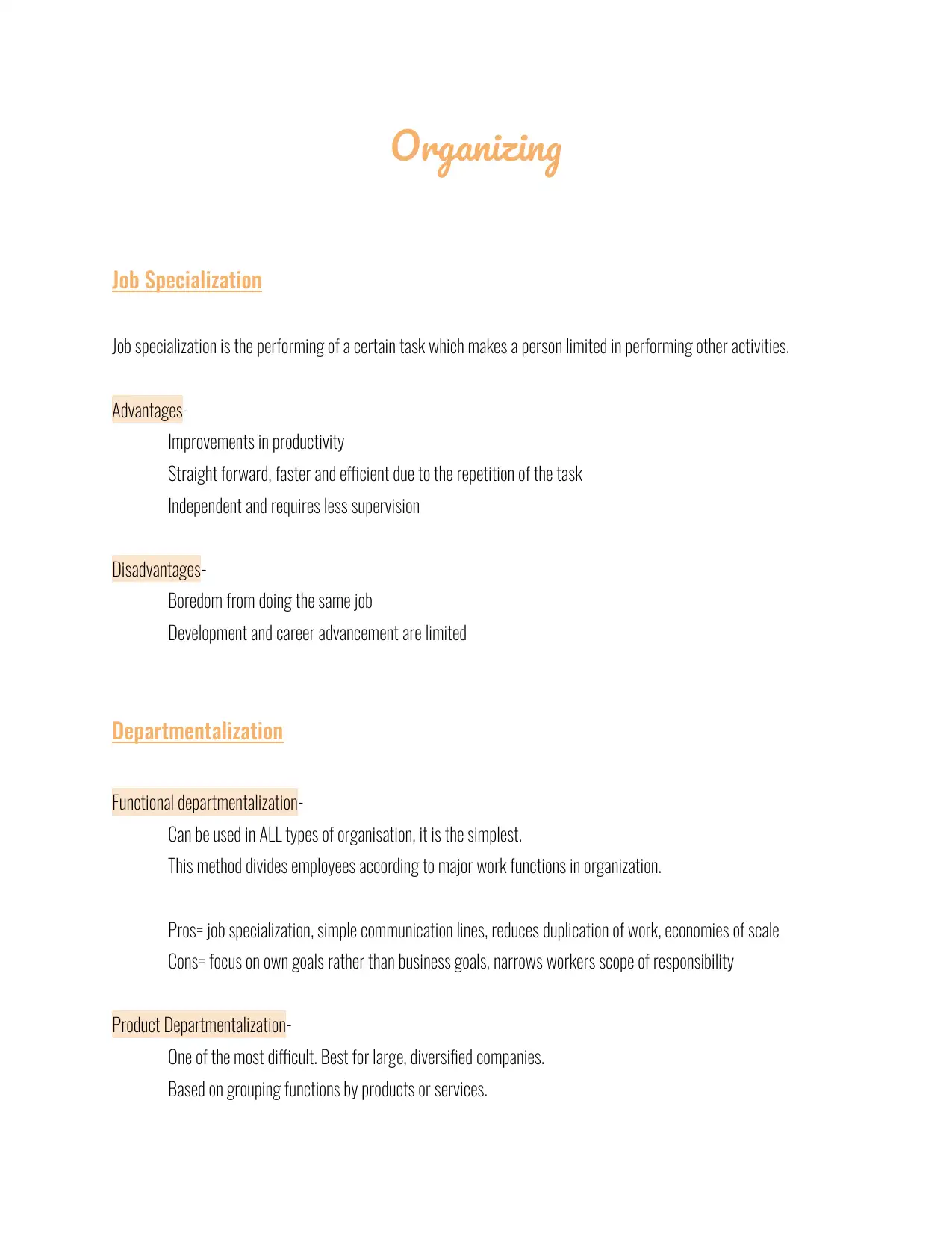
Organizing
Job Specialization
Job specialization is the performing of a certain task which makes a person limited in performing other activities.
Advantages-
Improvements in productivity
Straight forward, faster and efficient due to the repetition of the task
Independent and requires less supervision
Disadvantages-
Boredom from doing the same job
Development and career advancement are limited
Departmentalization
Functional departmentalization-
Can be used in ALL types of organisation, it is the simplest.
This method divides employees according to major work functions in organization.
Pros= job specialization, simple communication lines, reduces duplication of work, economies of scale
Cons= focus on own goals rather than business goals, narrows workers scope of responsibility
Product Departmentalization-
One of the most difficult. Best for large, diversified companies.
Based on grouping functions by products or services.
Job Specialization
Job specialization is the performing of a certain task which makes a person limited in performing other activities.
Advantages-
Improvements in productivity
Straight forward, faster and efficient due to the repetition of the task
Independent and requires less supervision
Disadvantages-
Boredom from doing the same job
Development and career advancement are limited
Departmentalization
Functional departmentalization-
Can be used in ALL types of organisation, it is the simplest.
This method divides employees according to major work functions in organization.
Pros= job specialization, simple communication lines, reduces duplication of work, economies of scale
Cons= focus on own goals rather than business goals, narrows workers scope of responsibility
Product Departmentalization-
One of the most difficult. Best for large, diversified companies.
Based on grouping functions by products or services.
Paraphrase This Document
Need a fresh take? Get an instant paraphrase of this document with our AI Paraphraser
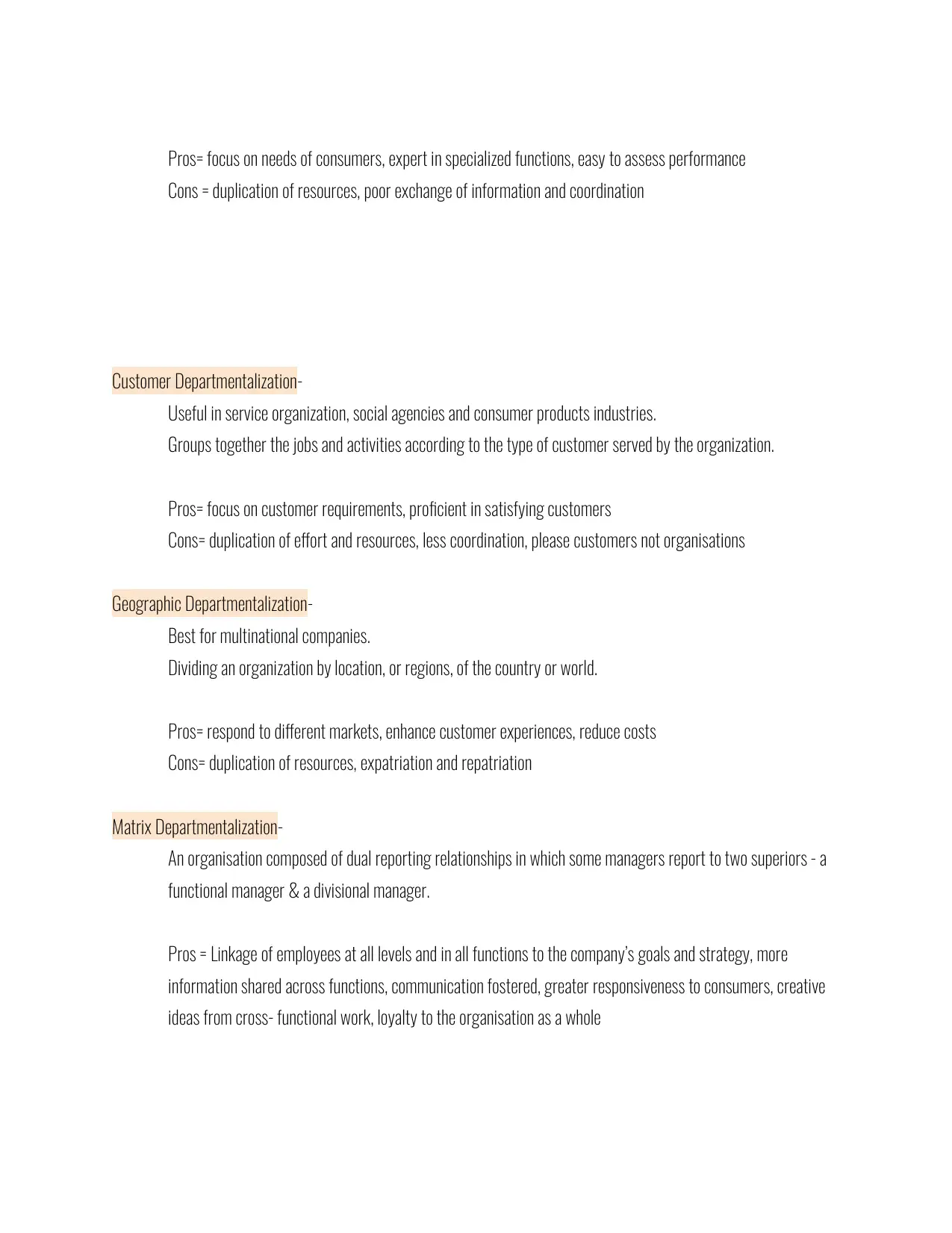
Pros= focus on needs of consumers, expert in specialized functions, easy to assess performance
Cons = duplication of resources, poor exchange of information and coordination
Customer Departmentalization-
Useful in service organization, social agencies and consumer products industries.
Groups together the jobs and activities according to the type of customer served by the organization.
Pros= focus on customer requirements, proficient in satisfying customers
Cons= duplication of effort and resources, less coordination, please customers not organisations
Geographic Departmentalization-
Best for multinational companies.
Dividing an organization by location, or regions, of the country or world.
Pros= respond to different markets, enhance customer experiences, reduce costs
Cons= duplication of resources, expatriation and repatriation
Matrix Departmentalization-
An organisation composed of dual reporting relationships in which some managers report to two superiors - a
functional manager & a divisional manager.
Pros = Linkage of employees at all levels and in all functions to the company’s goals and strategy, more
information shared across functions, communication fostered, greater responsiveness to consumers, creative
ideas from cross- functional work, loyalty to the organisation as a whole
Cons = duplication of resources, poor exchange of information and coordination
Customer Departmentalization-
Useful in service organization, social agencies and consumer products industries.
Groups together the jobs and activities according to the type of customer served by the organization.
Pros= focus on customer requirements, proficient in satisfying customers
Cons= duplication of effort and resources, less coordination, please customers not organisations
Geographic Departmentalization-
Best for multinational companies.
Dividing an organization by location, or regions, of the country or world.
Pros= respond to different markets, enhance customer experiences, reduce costs
Cons= duplication of resources, expatriation and repatriation
Matrix Departmentalization-
An organisation composed of dual reporting relationships in which some managers report to two superiors - a
functional manager & a divisional manager.
Pros = Linkage of employees at all levels and in all functions to the company’s goals and strategy, more
information shared across functions, communication fostered, greater responsiveness to consumers, creative
ideas from cross- functional work, loyalty to the organisation as a whole

Cons= Unclear responsibilities and competing priorities, Violation of the unity-of-command principles,
Accountability difficult to define, Possible conflict and stress for employees, More time consuming
Accountability difficult to define, Possible conflict and stress for employees, More time consuming
⊘ This is a preview!⊘
Do you want full access?
Subscribe today to unlock all pages.

Trusted by 1+ million students worldwide
1 out of 13
Related Documents
Your All-in-One AI-Powered Toolkit for Academic Success.
+13062052269
info@desklib.com
Available 24*7 on WhatsApp / Email
![[object Object]](/_next/static/media/star-bottom.7253800d.svg)
Unlock your academic potential
Copyright © 2020–2025 A2Z Services. All Rights Reserved. Developed and managed by ZUCOL.




